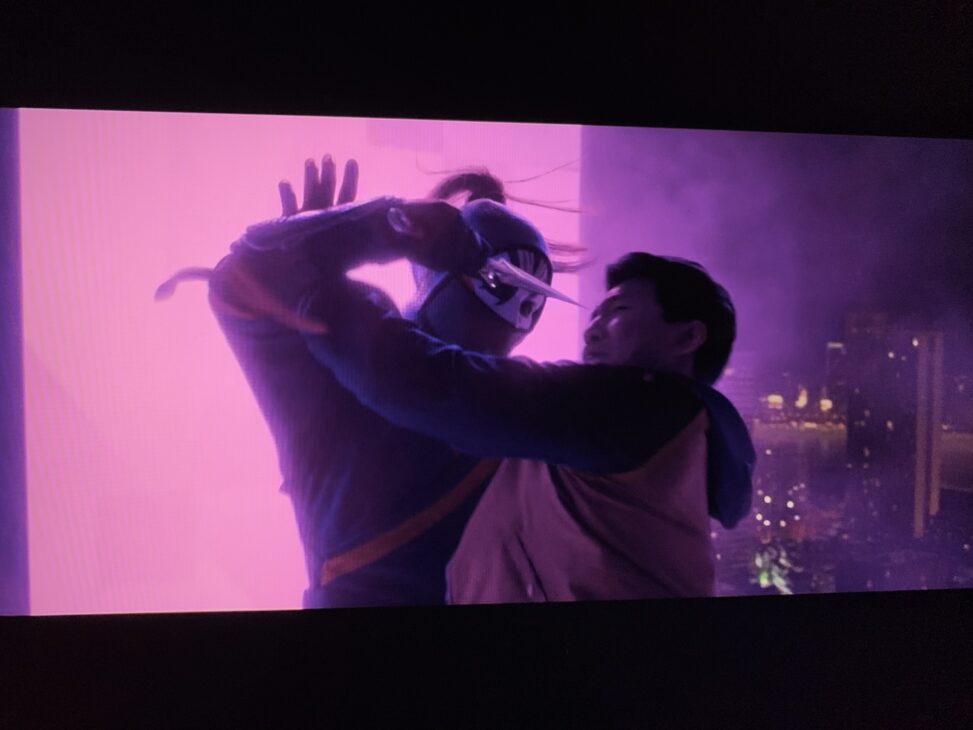Holly Bartels, T00663819
VISA 1500
Dr. Terryl Atkins
Assignment 4, part A
The image above is from Marvel’s Shang-Chi and The Legend of the Ten Rings, at the 42 minutes. Shown in the image, is the main character, Shang-Chi, struggling with a masked opponent in a tall building while being backlit with a purple glow. This movie follows the story of Shang-Chi as his dangerous past of having an immortal warlord father with the army of the Ten Rings, finally catches back up with him.
This scene was chosen for analysis, as it was an important fight for the main character, showing that despite managing to escape his father’s control before, he is still a product of the training he received while within the organization. The editing is fast paced, as both characters have a high-level of skill in Chinese martial arts (the main choice of combat shown in this film). The shots within this scene mix side full body shots, over the shoulder shots, and overhead shots. This fight is done with hand to hand as well as intermixing knife combat, hence the inclusion of the overhead view. The colour scheme for the two characters is similar, with navy, yellow, black, and red being used. This shows that despite the difference in costume style, both characters are of the same origin, as the masked antagonist is the one who helped train Shang-Chi. The location is within an unfinished floor of a skyscraper, but its lack of colour is remedied in the use of an electronic billboard casting purple and a greenish toned white onto the characters, adding to the visual excitement of the scene.
Being a Disney movie, the violence and blood not explicitly shown. The two characters are of Asian descent, as is most of the cast. This marks the first Marvel superhero movie to have an Asian lead, (Taylor, par. 4). Along with the fighting style being Chinese, large chunks of the film’s dialog is in Mandarin Chinese. With these three factors, this movie could be considered a Chinese martial arts film. The combination of Chinese concepts, elements and fighting style with the western action film dates to the 1960’s and 70’s, (Hongtu and Cai, p. 36). The result of their combination created the “martial art dance” that we see onscreen today with flowing choreography, (Hongtu and Cai, p. 36). Unfortunately, with this collision of the two cultures in the action film genre came the addition of “violent aesthetic elements,” (Hongtu and Cai p. 36) but with Shang-Chi, the increased explicit violence is not shown as much.
The men in this scene are highly skilled, and that level is seen in the female main characters too. They break the dated “China Doll” and “Dragon Lady” stereotypes that “Asian women faced in Hollywood film,” (Nagaraj and Wen, par 15-16). They are not there to serve and please men, nor act as the love interest only to betray the lead character, (Nagaraj and Wen, par. 15). All hold their own in defending themselves and have their own life outside of the main character’s.
On Rotten Tomatoes, the film received a 92% “certified fresh” rating from critics and a 98% from audiences, earning $22.4 million in the US, (Rotten Tomatoes). This film overall I believe had a positive impact with audiences for the same reason Black Panther (2018) had with audiences in the black community. This film allows children of Asian descent to have their own superhero like so many white children before them. The negative to this film, like other superhero and action films, is that violence is still seen as quick solution to problems.
References
Hongtu, Cui and Zhao Cai. “The Formal Evolution of Chinese Martial Arts Action Movies and the Spread of Core Values.” The Frontiers of Society, Science and Technology, Vol. 2, no. 4, 2020, p.36. Francis-Press, https://francis-press.com/uploads/papers/i2gn5XhwGUYEfqJ5TtEEjQ3bPvfxmGWICXpEo4ZZ.pdf . Accessed 18 November 2021.
Nagaraj, Sriganeshuarun and Chien Puu Wen. “Asian Stereotypes: Asian Representation in Hollywood Films.” INTI JOURNAL, 2020, par 15-16, http://eprints.intimal.edu.my/1485/1/vol.2020_063.pdf . Accessed 18 November 2021.
“Shang-Chi and the Legend of the Ten Rings.” Rotten Tomatoes, Fandango, Sept. 2021, https://www.rottentomatoes.com/m/shang_chi_and_the_legend_of_the_ten_rings . Accessed 18 November 2021.
Taylor, Alex. “Shang-Chi: Why the MCU’s First Asian Superhero Is Empowering Change.” BBC News, BBC, 3 Sept. 2021, https://www.bbc.com/news/entertainment-arts-58361669 . Accessed 19 November 2021.
